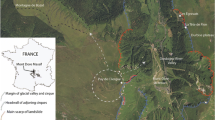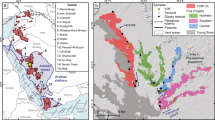Abstract
Here, we use observations of active flows along with detailed morphometric field measurements of more than 70 tumuli on flows at Mount Etna (Italy), Kilauea, and Hualalai (US) volcanoes to constrain a previously published model that estimates the pressure needed to form tumuli. In an attempt to discover the nature and magnitude of pressure variations within active lava flow interiors, we then consider how tumuli differ from idealized circular plates. We incorporate observations of active tumuli and find that they may grow asymmetrically yet produce a symmetrical tumulus and can form where the flow path significantly changes direction. Bending models of clamped edges provide the most reasonable head estimates for the tumuli in our study. Tumulus formation requires the proper combination of cooling and effusion rate. If cooling is too extensive and effusion rate too low, the crust will provide too much resistance to bending. If cooling is too limited and effusion rates too high, crusts will not develop or have insufficient strength to resist fracture and subsequent breakouts. We do not find it surprising that tumuli are rarely found over well-established lava tubes that typically have rigid, walls/overlying crusts that exceed 2 m in thickness and provide too much resistance to bending. Silicic flows lack tumuli because the viscosity gradients within the flow are insufficient to concentrate stress in a localized area.





Similar content being viewed by others
References
Anderson SW, Stofan ER, Smrekar SE, Guest JE, Wood B (1999) Evidence for pulsed inflation of pahoehoe sheet flows from surface fractures: implication for the emplacement of continental flood basalts. Earth Planet Sci Let 168:7–18
Anderson SW, Stofan ER, Smrekar SE, Guest JE, Wood B (2000) Reply to Self et al., 2000, Comment on “Pulsed inflation of pahoehoe lava flows: Implications for flood basalt emplacement”. Earth Planet Sci Let 179:425–428
Anderson SW, McColley S, Fink JH, Hudson R (2005) The development of fluid instabilities and preferred pathways in lava flow interiors: insights from analog experiments and fractal analysis. In: Manga M, Ventura G (eds) Kinematics and dynamics of lava flows, Geol Soc of Am Spec Pap 396., pp 147–161. doi:10.1130/2005.2396(10)
Anderson SW, Stofan ER, Smrekar SE, Finnegan D, Byrne JM, Ramsey M, Nicoll K (2008) The growth of active flow-lobe tumuli: field observations and terrestrial LIDAR data. 2008 IAVCEI Conference Abstract, Reykjavic, Iceland
Andrew REB, Gudmundsson A (2007) Distribution, structure, and formation of Holocene lava shields in Iceland. J Volc Geotherm Res 168:137–154
Berger SA, Talbot L, Yao LS (1983) Flow in curved pipes. Annu Rev Fluid Mec 15:461–512. doi:10.1146/annurev.fl.15.010183.002333
Burkhard DJM (2003) Thermal interaction between lava lobes. Bull Volcanol 65:136–143
Byrnes JM, Crown DA (2001) Relationships between pahoehoe surface units, topography and lava tubes at Mauna Ulu, Kilauea Volcano, Hawaii. J Geophys Res 106:2139–2151
Calvari S, Pinkerton HA (1998) Formation of lava tubes and extensive flow field during the 1991–1993 eruption of Mount Etna. J Geophys Res 103:27291–27301
Coussot P (1999) Saffman–Taylor instability for yield stress fluids. J Fluid Mech 380:363–376
Dragoni M, Piombo A (2009) Thermoelastic deformation associated with a lava tube. Bull Volc 71:409–418. doi:10.1007/s00445-008-0248-4
Duncan AM, Guest JE, Stofan E, Anderson SW, Pinkerton H, Calvari S (2004) Development of tumuli in the medial portion of the 1983 aa flow-field, Mount Etna, Sicily. J Volc Geotherm Res 132:173–187
Duraiswami RA, Bondre NR, Dole G, Phadnis VM, Kale VS (2001) Tumuli and associated features from the western Deccan Volcanic Province, India. Bull Volc 63:435–442
Glaze LS, Anderson SW, Stofan ER, Baloga S, Smrekar SE (2005) Statistical distribution of tumuli on pahoehoe flow surfaces: Analysis of examples in Hawaii and Iceland and potential applications to lava flows on Mars. J Geophys Res 110:B08202. doi:10.1029/2004JB003564
Giacomini L, Massironi M, Martellato E, Pasquarè G, Frigeri A, Cremonese G (2009) Inflated flows on Daedalia Planum (Mars)? Clues from a comparative analysis with the Payen volcanic complex (Argentina). Planet Sp Sci 57:556–570
Gudmundsson A (1999) Postglacial crustal doming, stresses and fracture formation with application to Norway. Tectonophysics 307:407–419
Gudmundsson A (1983) Stress estimates from the length/width rations of fractures. J Struct Geol 5:623–626
Guest J, Duncan A, Stofan ER, Anderson SW (2011) Effect of slope on development of pahoehoe flow fields: Evidence from Mount Etna. J Volca Geotherm Res (in press)
Hallot E, Davy P, d’Ars JB, Auvray B, Martin H, Van Damme H (1996) Non-newtonian effects during injection in partially crystallised magmas. J Volc Geotherm Res 71:31–44
Heliker CC, Mattox TN (2003) The first two decades of the Pu'u 'O'o-Kupaianaha eruption: chronology and selected bibliography. US Geol Surv Prof Pap 1676:1–28
Helfrich KR (1995) Thermo-viscous fingering of flow in a thin gap: a model of magma flow in dikes and fissures. J Fluid Mech 305:219–238
Holcomb RT (1976) Preliminary map showing products of eruptions, 1962-1974, from the upper east rift zone of Kilauea Volcano, Hawaii. US Geol Surv Misc Field Studies Map MF-81
Hon K, Kauahikaua J, Denlinger R, Mackay K (1994) Emplacement and inflation of pahoehoe sheet flows: Observations and measurements of active lava flows on Kilauea Volcano, Hawaii. Geol Soc Am Bull 106:351–370
Houle MG, Prefontaine S, Fowler AD, Gibson HL (2009) Endogenous growth in channelized komatiite lava flows: evidence from spinifex-textured sills at Pyke Hill and Serpentine Mountain, Western Abitibi Greenstone Belt, Northeastern Ontario, Canada. Bull Volcanol 71:881–901
Kauahikaua J, Cashman KV, Clague DA, Champion D, Hagstrum JT (2002) Emplacement of the most recent lava flows on Hualalai Volcano, Hawaii. Bull Volc 64:229–253. doi:10.1007/s00445-001-0196-8
Kauahikaua J, Cashman KV, Mattox TN, Heliker CC, Hon KA, Mangan MT, Thornber CR (1998) Observations on basaltic lava streams in tubes from Kilauea Volcano, island of Hawaii. J Geophys Res 103:27303–27323
Kauahikaua J, Mangan MT, Mattox TN (1996) A quantitative look at the demise of a basaltic vent: the death of Kupaianaha. Bull Volc 57:641–648
Keszthelyi L, Jaeger W, McEwen A, Beyer RA, Dundas C, Milazzo M (2008) High Resolution Imaging Science Experiment (HiRISE) images of volcanic terrains from the first 6 months of the Mars Reconnaissance Orbiter Primary Science Phase. J Geophys Res 113:E04005. doi:10.1029/2007JE002968
Kilburn CRJ (1993) Lava crusts, aa flow lengthening and the pahoehoe-aa transition. In: Kilburn CRJ, Luoungo G (eds) Active lavas: monitoring and modeling. UCL Press, London, pp 263–280
Mattox TN, Heliker C, Kauahikaua J, Hon K (1993) Development of the 1990 Kalapana flow field, Kilauea volcano, Hawaii. Bull Volc 55:407–413
Mattsson HB, Hoskuldsson A (2005) Eruption reconstruction, formation of flow-lobe tumuli and eruption duration in the 5900 BP Helgafell lava field (Heimaey), south Iceland. J Volc Geotherm Res 147:157–172
Pinkerton H, Sparks RSJ (1978) Field measurements of the rheology of flowing lava. Nature 276:383–385
Pollard DD, Muller OH, Dockstader DR (1975) The form and growth of fingered sheet intrusions. Geol Soc Am Bull 86:351–363
Romano R, Sturiale C (1982) The historical eruptions of Mt. Etna (volcanological data). In: Romano R (ed) Mount Etna Volcano, a Review of Recent Earth Science Studies. Mem Soc Geol Italia 23:75–97
Rossi MJ, Gudmundsson A (1996) The morphology and formation of flow-lobe tumuli and Icelandic shield volcanoes. J Volc Geotherm Res 72:291–308
Rowland SK, Walker GPL (1990) Pahoehoe and aa in Hawaii: volumetric flow rate controls the lava structure. Bull Volc 52:615–628
Ryan MP, Sammis CG (1981) The glass transition in basalt. Jour Geophys Res 86:9519–9539
Saffman PG, Taylor G (1958) The penetration of a fluid into a porous medium or Hele-Shaw cell containing a more viscous liquid. Proc R Soc London A245:312–239
Schaefer CJ, Kattenhorn SA (2004) Characterization and evolution of fractures in low-volume pahoehoe flows, eastern Snake River Plain, Idaho. Geol Soc Am Bull 116:322–336
Self S, Keszthelyi L, Thordarson T (1998) The importance of pahoehoe. Ann Rev Earth Planet Sci 26:81–110
Shaw HR (1969) Rheology of basalt in the melting range. J Petrology 10:510–535
Ugural AC (1981) Stresses in plates and shells. McGraw Hill, New York
Walker GPL (1991) Structures and origin by injection of lava under surface crust of tumuli, "lava rises", "lava rise pits", and "lava inflation clefts" in Hawaii. Bull Volc 53:546–558
Weeraratne DS, Forsyth DW, Parmentier EM (2003) An alternative model for the origin of non-hotspot intraplate volcanism in the Pacific. The hotspot handbook. Proc Penrose Conf Plume IV: Beyond the Plume Hypothesis, Iceland
Wylie JJ, Voight B, Whitehead JA (1999a) Instability of magma flow with volatile-dependent viscosity. Science 285:1883
Wylie JJ, Helfrich KR, Dade B, Lister JR, Salzig JF (1999b) Flow localization in fissure eruptions. Bull Volc 60:432–440
Acknowledgments
The authors wish to acknowledge John Guest, Angus Duncan, Jeff Byrnes, David Crown, and Mike Ramsey for discussions in the field that helped us develop the ideas presented here. Anderson acknowledges support from grant NNG05GL55G from the NASA Mars Fundamental Research Program. We also thank Agust Gudmundsson and an anonymous reviewer for their extremely thorough and thoughtful critiques that helped us focus and clarify this work.
Author information
Authors and Affiliations
Corresponding author
Additional information
Editorial responsibility: A. Harris
Rights and permissions
About this article
Cite this article
Anderson, S.W., Smrekar, S.E. & Stofan, E.R. Tumulus development on lava flows: insights from observations of active tumuli and analysis of formation models. Bull Volcanol 74, 931–946 (2012). https://doi.org/10.1007/s00445-012-0576-2
Received:
Accepted:
Published:
Issue Date:
DOI: https://doi.org/10.1007/s00445-012-0576-2




